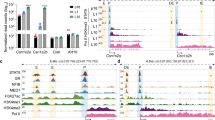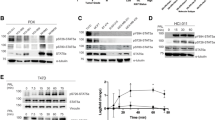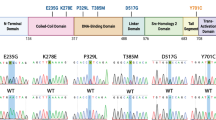Abstract
STATs (signal transducers and activators of transcription) are proteins with dual functions: signal transducers in the cytoplasm and transcriptional activators in the nucleus. STAT proteins act as transcription factors activated by phosphorylation on its tyrosine residues upon stimulation by various cytokines. The phosphorylated STAT molecules then form homo- or heterodimers through SH2-mediated interaction and translocate into the nucleus to activate the transcription of various target genes. STAT5 recognizes the interferon-γ activated site TTCNNNGAA (GAS sequence) in the promoter region of the β-casein gene. Except for prolactin-dependent β-casein production in mammary gland cells, the biological consequences of STAT5a activation in various systems are not clear. Here we showed that STAT5a was phosphorylated 10 min after desferrioxamine (DFO) treatment, and reached a maximum induction at 4 h in mammary epithelial cells (HC11) and transfected COS-7 cells. Under hypoxic conditions (2% O2), a maximal phosphorylation of STAT5a was observed within 6 h. EMSA (electrophoretic mobility shift assay) showed that DFO or hypoxia enhanced the binding activities of STAT5a DNA to β-casein gene promoter in mammary epithelial cells (HC11) and transfected COS-7 cells. These results showed that DFO or hypoxia induces tyrosine phosphorylation of STAT5a and also increases the binding activity of STAT5a DNA in mammary epithelial cells. Our data suggest that the STAT5 may act as a mediator in hypoxia-mediated gene expression.
Similar content being viewed by others
Article PDF
Author information
Authors and Affiliations
Rights and permissions
This is an Open Access article distributed under the terms of the Creative Commons Attribution Non-Commercial License (http://creativecommons.org/licenses/by-nc/3.0/) which permits unrestricted non-commercial use, distribution, and reproduction in any medium, provided the original work is properly cited.
About this article
Cite this article
Joung, YH., Park, JH., Park, T. et al. Hypoxia activates signal transducers and activators of transcription 5 (STAT5) and increases its binding activity to the GAS element in mammary epithelial cells. Exp Mol Med 35, 350–357 (2003). https://doi.org/10.1038/emm.2003.46
Published:
Issue date:
DOI: https://doi.org/10.1038/emm.2003.46
This article is cited by
-
Emerging evidence of the physiological role of hypoxia in mammary development and lactation
Journal of Animal Science and Biotechnology (2014)
-
Isolation and characterization of dominant and recessive IL-3-independent hematopoietic transformants
Oncogene (2006)
-
HIF-1α, STAT3, CBP/p300 and Ref-1/APE are components of a transcriptional complex that regulates Src-dependent hypoxia-induced expression of VEGF in pancreatic and prostate carcinomas
Oncogene (2005)
-
Hypoxia-responsive transcription factors
Pflügers Archiv - European Journal of Physiology (2005)



